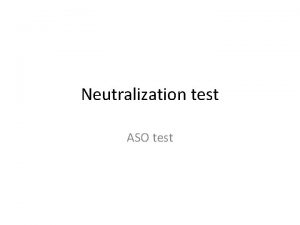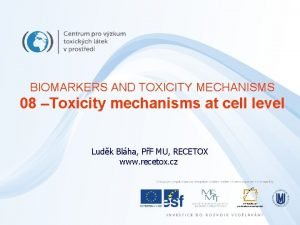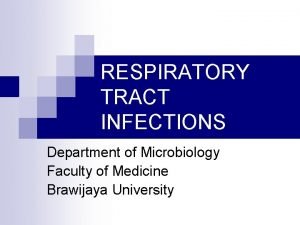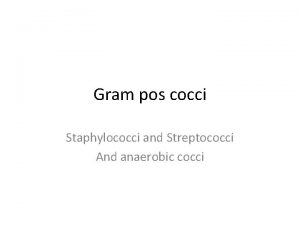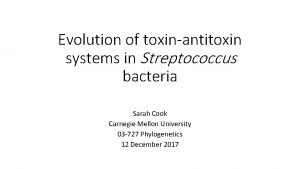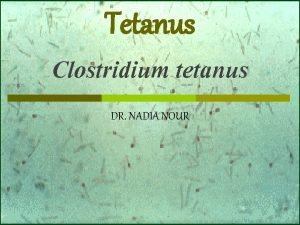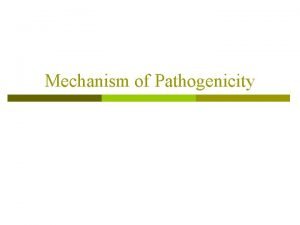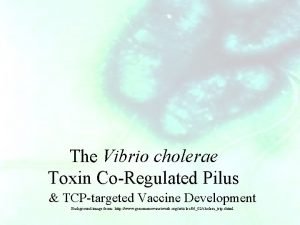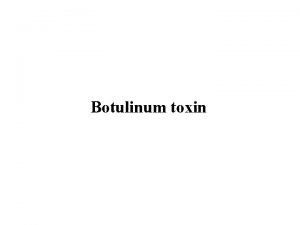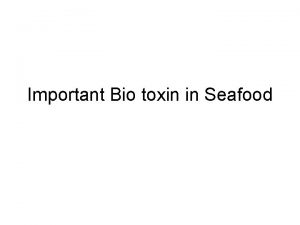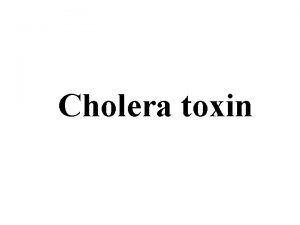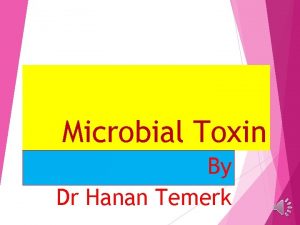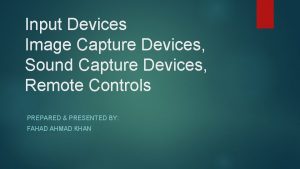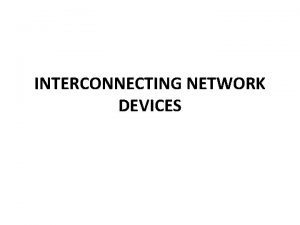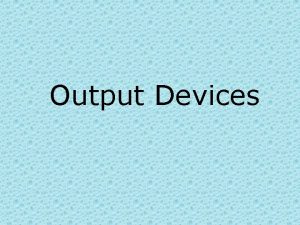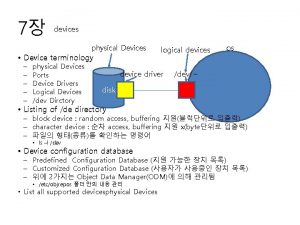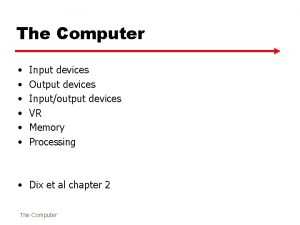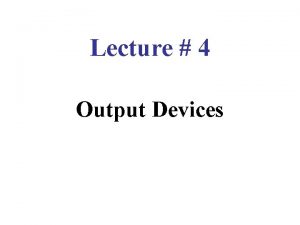Development of new devices for toxin detection Carmen




































- Slides: 36

Development of new devices for toxin detection Carmen Moldovan, Rodica Iosub, Bogdan Firtat, Daniel Necula, *Eric Moore, *Gheorghe Marin IMT –Bucharest *Tyndall National Institute, Cork Bucharest, 6 th of December “Cooperation in FP 7 Biomedical applications of micro and nanotechnologies”

Development of a toxin screening multiparameter on-line biochip system. Toxi. Chip Proposal No. 27900 Bucharest, 6 th of December micro and nanotechnologies” “Cooperation in FP 7 Biomedical applications of

Toxichip Objective • Alternative in-vitro testing methods for the monitoring of toxichemicals • A eukaryote cell based biochip that examines the effects of toxichemicals on cell impedance, morphology, distribution and p. H • A panel of genetically engineered bacterial strains that optically report on the presence of toxichemicals that normally affect eukaryotic cells • A prokaryote based biochip that uses optical analysis to measure the signal (fluorescence, bioluminescence) emitted by the bacteria in the presence of different toxichemicals • Develop a microfluidic system with temperature control and p. H sensor Bucharest, 6 th of December “Cooperation in FP 7 Biomedical applications of micro and nanotechnologies”

Eukaryote cell-based biochip • Comprise of finger electrodes composed of indium tin oxide (ITO) • ITO will be used as an impedance sensor that allows real time noninvasive in-vitro analysis • Biochip will function in a “plug-in-play” mode that will facilitate its insertion into the microfluidic platform Inlet Temperature sensor p. H sensor Connector Outlet Dipstick Solid Support Bucharest, 6 th of December Impedance sensor O-ring “Cooperation in FP 7 Biomedical applications of micro and nanotechnologies”

Further Objectives • specialised interfaces that links the biochip to a PC, that record data and provides on-line continuous information on microfluidics, electrochemical signals, temperature and p. H • Develop a management software for project experiments, such as data acquisition, parameters control and data mining • Performance evaluation of the biochips will be done for the various integrated sensing capabilities - optical and electrochemical detection • Characterise/Validate the biochips by using a combination of cellular bioassays and evaluating the biological effects of high doses and low doses, the impacts on DNA and endocrine perturbations on the bioassays. Bucharest, 6 th of December “Cooperation in FP 7 Biomedical applications of micro and nanotechnologies”

Participant no. Participant name Abbreviation 1 (coordinator) Tyndall National Institute Tyndall 2 Hebrew University of Jerusalem HUJ 3 National Institute for Research and Development in Microtechnologies IMT 4 Joint Research Centre JRC 5 Tel Aviv University TAU 6 Scienion AG Scienion 7 Vigicell SAS Vigicell 8 Istituto Superiore Mario Boella ISMB Bucharest, 6 th of December “Cooperation in FP 7 Biomedical applications of micro and nanotechnologies”

1. National Institute for Research and Development in Microtechnologies (Romania) • Microsystems research Simulation, design, technology, biosensors, electrodes for biological sensors, microprobes for recording of electrical activity of cells • Technological development: -Micromachining techniques for silicon, glass and ceramics, -Immobilization technique of enzymes on electrodes -Spin deposition of thin film sensitive polymers Bucharest, 6 th of December “Cooperation in FP 7 Biomedical applications of micro and nanotechnologies”

Schematic of Toxichip Operating System Electrode Surface Chemistry + Cells + PC EIS Biochip + Platform Interface Inverted Phase-contrast/Fluorescent Microscope coupled with CCD camera Bucharest, 6 th of December “Cooperation in FP 7 Biomedical applications of micro and nanotechnologies”

Development of temperature sensor integrated with the microfluidic platform • Simulation and design of the temperature sensor together with the microfluidic part where the sensor is integrated. • Study of the compatibility of the sensor with the chemical aggressive working environment. • Biocompatibility of the microsensor materials with the biological media. • Experiments, manufacturing design and testing. Development of p. H sensors integrated with the microfluidic platform • Development of the p. H sensor together with the microfluidic part where the sensor is positioned. • Development of materials, manufacturing steps, experiments and testing. Bucharest, 6 th of December “Cooperation in FP 7 Biomedical applications of micro and nanotechnologies”

Three channels 1 mmx 1 mm each Bucharest, 6 th of December “Cooperation in FP 7 Biomedical applications of micro and nanotechnologies”

1 channel flow Bucharest, 6 th of December “Cooperation in FP 7 Biomedical applications of micro and nanotechnologies”

3 channels flow Bucharest, 6 th of December “Cooperation in FP 7 Biomedical applications of micro and nanotechnologies”

2 mm x 2 mm channels with enlarged areas (4 mmx 2 mm) hosting sensors and Cells (6 mm exhaust) Mesh: Bucharest, 6 th of December “Cooperation in FP 7 Biomedical applications of micro and nanotechnologies”

Flow analysis Bucharest, 6 th of December “Cooperation in FP 7 Biomedical applications of micro and nanotechnologies”

Flow analysis (details) Bucharest, 6 th of December “Cooperation in FP 7 Biomedical applications of micro and nanotechnologies”

Analysis of the flow rate by square section channels Bucharest, 6 th of December “Cooperation in FP 7 Biomedical applications of micro and nanotechnologies”

Analysis of the flow rate by square section channels (one active entry – detail) Bucharest, 6 th of December “Cooperation in FP 7 Biomedical applications of micro and nanotechnologies”

Flow rate analysis considering a round shape of the enlarged area hosting ITO electrode (three entries in the exhaust channel) Bucharest, 6 th of December “Cooperation in FP 7 Biomedical applications of micro and nanotechnologies”

Flow rate analysis considering a round shape of the enlarged area hosting ITO electrode (detail) Bucharest, 6 th of December “Cooperation in FP 7 Biomedical applications of micro and nanotechnologies”

Flow rate analysis considering a round shape of the enlarged area hosting ITO electrode (one entry in the exhaust channel) Bucharest, 6 th of December “Cooperation in FP 7 Biomedical applications of micro and nanotechnologies”

Flow rate analysis considering a round shape of the enlarged area hosting ITO electrode (one entry in the exhaust channel) - detail Bucharest, 6 th of December “Cooperation in FP 7 Biomedical applications of micro and nanotechnologies”

Flow rate analysis considering a round shape of the enlarged area hosting ITO electrode Bucharest, 6 th of December “Cooperation in FP 7 Biomedical applications of micro and nanotechnologies”

Flow rate analysis Bucharest, 6 th of December “Cooperation in FP 7 Biomedical applications of micro and nanotechnologies”

Technological flow – microfluidic channels 1. Material – PDMS 2. Patterning Laser machining Goal: study, set-up and optimisation of the microfluidic channels issues: design, technology, connections, integration into the platform Bucharest, 6 th of December “Cooperation in FP 7 Biomedical applications of micro and nanotechnologies”

Microfluidic channels Bucharest, 6 th of December “Cooperation in FP 7 Biomedical applications of micro and nanotechnologies”

Microfluidic channels Bucharest, 6 th of December “Cooperation in FP 7 Biomedical applications of micro and nanotechnologies”

Sensors cell Sensors Unit p. H Signal Processing Unit Reference Temperature sensor Bucharest, 6 th of December “Cooperation in FP 7 Biomedical applications of micro and nanotechnologies”

Results: • Design of the microfluidic platform • Study of sensors, materials, technological versions; test structure utilisation • Design of the sensors • Interconnection layer design - draft Bucharest, 6 th of December “Cooperation in FP 7 Biomedical applications of micro and nanotechnologies”

Biosensors for neurotoxic substances detection The biosensors for neurotoxic substances will be developed as ISFET-type biosensors. The ISFET structure is represented by a concentration-potential transducer, with a biosensitive layer deposited on the gate (Acetylcholinesterases, immobilised on chitosane), which generates an interface potential on the gate. The enzymatic ISFET structure is developed in CMOS technology and the sensor’s response characteristics depend mainly on the ACh. E enzyme immobilisation mode. Optical photography of the sensor chip Bucharest, 6 th of December “Cooperation in FP 7 Biomedical applications of micro and nanotechnologies”

ISFET and chemoresistive sensors Principle: : The change in conductivity at the sensitive layer surface, deposited on top of the sensor. Characterisation The enzyme electrode is a combination of any electrochemical probe (amperometric, potentiometric or conductometric) with a thin layer (10 200 mm) of immobilized enzyme. In these devices, the function of the enzyme is providing selectivity by virtue of its biological affinity for a particular substrate molecule. For example, an enzyme is capable of catalyzing a particular reaction of a given substrate even though other isomers of that substrate or similar substrates may be present Bucharest, 6 th of December “Cooperation in FP 7 Biomedical applications of micro and nanotechnologies”

Bio integration I. Surface Chemistry Functionalization The silicon or glass substrates are functionalized as hydrophobic, hydrophilic, biocompatible surfaces Available procedures: Cleaning procedures Chemical Vapor Deposition: CVD, PSG, BPSG Polymer Adlayers: SU-8, Organosilanes (Rn-Si-X(4 -n)) Passivation (treatment in N 2 and H 2) Immobilization technique Ex: After surface functionalization , the immobilised ACh. E enzyme within a chitosan biolayer laid on the sensor structure -O O H H HO C H Si. O 2 -O H NH 2 O ( O HO Si. O 2 Bucharest, 6 th of December H O O O NH 2 H C H H ) n. H H O N H H ACh. E “Cooperation in FP 7 Biomedical applications of micro and nanotechnologies”

Field effect gas sensors are based on metal-insulator-semiconductor structures used to detect chemical quantities. Examples are biological and medical applications. The surface field effect is a desirable mechanism for a generating potential that provides high chemical selectivity and sensitivity. Using micromachining techniques we manufactured an ISFET device with posibility of integrating an area of sensing devices and the electronics on the same chip; ISFET sensors use the field effect transistors to detect very small quantities (10 -3 g). Simulation and Layout of a FET sensor on the tip of a microprobe Bucharest, 6 th of December “Cooperation in FP 7 Biomedical applications of micro and nanotechnologies”

II. Deposition and characterization of biological materials Deposition –Plotter (Omni. Grid Micro): Biological materials deposition for biosensors manufacturing Enzyme based biosensor Immobilized enzyme on gold electrodes Characterization – Scanner (Gene. TAC UC 4 Microarray scanner) Enzyme based biosensor (fluorescence) Bucharest, 6 th of December “Cooperation in FP 7 Biomedical applications of micro and nanotechnologies”

III. Biosensors Devices design and fabrication including masks processing • Microelectrodes to be deposited with biomaterials IMT can provide a wide range of microelectrodes design and manufacturing, for biomaterials applications. The microelectrodes can be deposited and configured on silicon substrates in our technological facilities. • ISFET sensor for ions detection in biological media The surface field effect is a desirable mechanism for a generating potential that provides high chemical selectivity and sensitivity. The ISFET is essentially an extended gate field effect transistor with the surface of the transistor and the reference electrode. Bucharest, 6 th of December Example of microelectrodes layout, for biomaterials applications ISFET sensor placed on a thin tip to be inserted in small liquid media “Cooperation in FP 7 Biomedical applications of micro and nanotechnologies”

Microfluidics devices development: design, simulations, manufacturing Design and simulations for microfluidics devices, including general flow, thermal, fluid mixing, electrokinetic, chemical reactions, etc. Bucharest, 6 th of December “Cooperation in FP 7 Biomedical applications of micro and nanotechnologies”

THANK YOU! • The paper is presenting the result of two projects: Toxichip, IST, STREP Toxisystem, Romanian Security Programme Bucharest, 6 th of December “Cooperation in FP 7 Biomedical applications of micro and nanotechnologies”
 Asot test principle
Asot test principle Cholera toxin
Cholera toxin Toxin neutralization test
Toxin neutralization test The teflon toxin
The teflon toxin Erythrogenic toxin
Erythrogenic toxin Biochemical test
Biochemical test Bacteria toxin
Bacteria toxin Anthrax toxin mechanism of action
Anthrax toxin mechanism of action Anthrax toxin mechanism of action
Anthrax toxin mechanism of action Toxin-coregulated pilus
Toxin-coregulated pilus Fspos
Fspos Novell typiska drag
Novell typiska drag Nationell inriktning för artificiell intelligens
Nationell inriktning för artificiell intelligens Ekologiskt fotavtryck
Ekologiskt fotavtryck Varför kallas perioden 1918-1939 för mellankrigstiden
Varför kallas perioden 1918-1939 för mellankrigstiden En lathund för arbete med kontinuitetshantering
En lathund för arbete med kontinuitetshantering Underlag för särskild löneskatt på pensionskostnader
Underlag för särskild löneskatt på pensionskostnader Personlig tidbok för yrkesförare
Personlig tidbok för yrkesförare A gastrica
A gastrica Densitet vatten
Densitet vatten Datorkunskap för nybörjare
Datorkunskap för nybörjare Tack för att ni lyssnade bild
Tack för att ni lyssnade bild Hur skriver man en tes
Hur skriver man en tes Autokratiskt ledarskap
Autokratiskt ledarskap Nyckelkompetenser för livslångt lärande
Nyckelkompetenser för livslångt lärande Påbyggnader för flakfordon
Påbyggnader för flakfordon Arkimedes princip formel
Arkimedes princip formel Publik sektor
Publik sektor Lyckans minut erik lindorm analys
Lyckans minut erik lindorm analys Presentera för publik crossboss
Presentera för publik crossboss Teckenspråk minoritetsspråk argument
Teckenspråk minoritetsspråk argument Vem räknas som jude
Vem räknas som jude Klassificeringsstruktur för kommunala verksamheter
Klassificeringsstruktur för kommunala verksamheter Mjälthilus
Mjälthilus Claes martinsson
Claes martinsson Centrum för kunskap och säkerhet
Centrum för kunskap och säkerhet Programskede byggprocessen
Programskede byggprocessen
